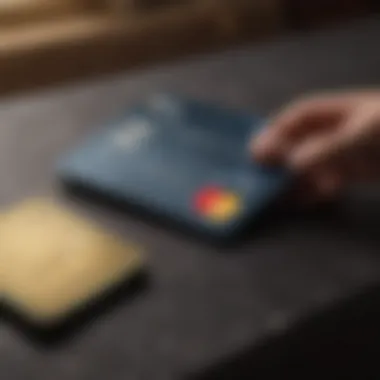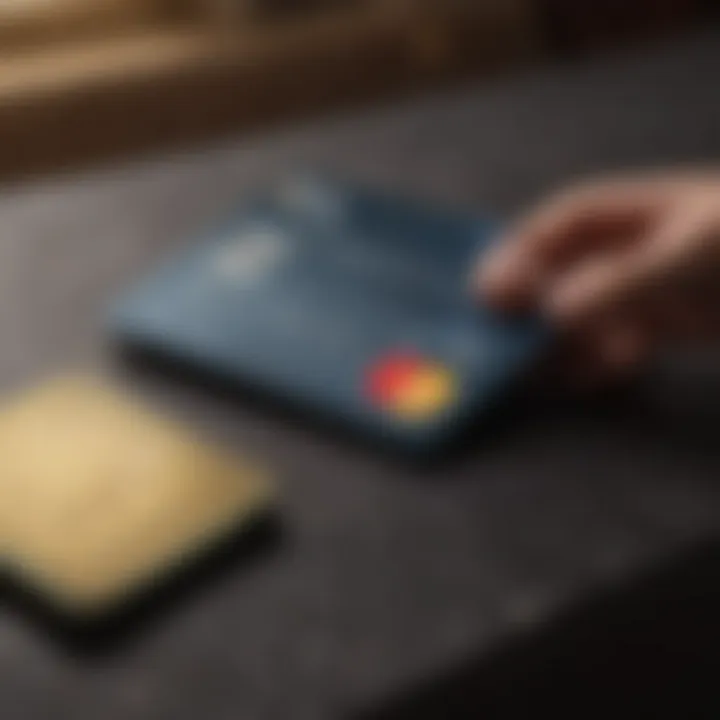Understanding Credit Card Transactions: A Detailed Overview


Intro
In today’s fast-paced world, where plastic reigns supreme, understanding the nuts and bolts of credit card transactions is more crucial than ever. Whether you're a seasoned financial aficionado or merely growing your awareness about personal finance, grasping the intricacies of how credit cards function can dramatically influence your financial choices. This journey begins the moment a customer decides to swipe or tap their card. From there, various voiceless entities come together in a choreographed ballet of processing that ensures the transaction is completed smoothly.
By peeling back the layers of these transactions, we also uncover the responsibilities that come with card ownership, the role merchants play, and the pivotal involvement of financial institutions. Moreover, the cutting-edge technologies that secure these exchanges deserve a spotlight of their own, as they are the unsung heroes behind the scenes. Understanding these aspects can guide individuals in making informed decisions about credit card usage, impacts on personal finance, and broader economic implications.
The exploration will address key definitions and terminology that will clear the fog, making everything more tangible. We'll tap into expert insights, ensuring you're not just learning about the mechanics but also gaining advice from those who’ve navigated these waters before. So - buckle up for a deep dive into the labyrinth of credit card transactions.
Intro to Credit Card Transactions
Credit card transactions have become a staple in modern finance, serving as a bridge between consumer convenience and the intricate workings of the financial system. As we delve into this topic, it’s crucial to grasp both the basic functioning of credit cards and their broader implications. Understanding credit card transactions not only equips consumers with the knowledge to make informed decisions but also fosters a healthy relationship with personal finance.
Definition of Credit Cards
A credit card is essentially a small rectangular piece of plastic or metal that gives the holder access to a credit limit set by the issuing bank or financial institution. With this limit, consumers can purchase goods and services without having to pay cash upfront. Instead of settling the amount immediately, cardholders can borrow against their available credit, repaying the issuer over time, often with interest. Many folks may think of it as a convenient means to shop, but at its core, it’s a kind of short-term loan agreement.
The features of credit cards can vary widely, but let’s take a closer look at some key elements:
- Credit Limit: The maximum amount that can be borrowed. Exceeding this limit can lead to declined transactions or fees.
- Interest Rates: Often referred to as APR (annual percentage rate), it represents the cost of borrowing on the card balance.
- Rewards Programs: Some cards offer perks such as cash back, travel points, and other incentives for usage.
- Fees: This includes annual fees, late payment fees, and foreign transaction fees, which can sneak up on unwary consumers.
By understanding these definitions, consumers gain essential insights into how to navigate credit card use effectively.
The Role of Credit in Personal Finance
Credit plays an immensely significant role in personal finance; it can be both a helpful tool and a dangerous trap. At its best, it enables individuals to manage cash flow, make significant purchases, or address unexpected financial challenges without immediately disrupting their savings.
Consider this: about 70% of Americans have a credit card, reflecting its importance in household budgeting. When managed wisely, a credit card can help establish a solid credit history—key for bigger financial decisions like purchasing a home or car. But there’s a duality here, often seen in the phrase, "with great power comes great responsibility." Poor credit management can lead to spiraling debt, impacting financial stability and credit scores adversely.
Furthermore, understanding the role of credit in personal finances includes recognizing:
- Budgeting: Using credit can aid in bridging gaps between income and expenses.
- Building Credit: Responsible use can enhance credit scores, leading to better loan rates in the future.
- Planning for Emergencies: Credit can serve as a lifeline in times of need, albeit caution should be exercised.
"Managing credit is like balancing on a tightrope; a little misstep can lead to significant consequences."
The Payment Process Explained
Understanding the payment process is fundamental in demystifying how credit card transactions function. This section breaks down the step-by-step journey of a credit card transaction—an act that most people perform frequently yet may not fully grasp. From the moment a consumer decides to make a purchase to when the payment clears, each stage is a cog in a larger machine that facilitates commerce. Grasping the nuances of this process sheds light on personal financial management, enabling consumers to navigate fees, security measures, and their own spending habits more effectively.
Initiating a Transaction
When you swipe your credit card at the checkout or tap it against a contactless terminal, the transaction is set into motion. This first step, known as initiating a transaction, involves the cardholder presenting their card information to the merchant for payment. During this phase, information like the credit card number, expiration date, and the card's security code are essential.
It’s noteworthy that the way these transactions are set up can vary by merchant. Many businesses today offer multiple ways to initiate payments, including online platforms, apps, and physical card readers. For a smoother transaction experience, ensure that the merchant’s technology is compatible with your card type and features.
Key Points of Initiating a Transaction:
- Presentation of payment information
- Types of accepted payment methods
- Merchant's technology integration
Authorization Requests
Once the payment information is sent, the merchant's systems generate an authorization request. This request travels through several channels to the card issuer, which is the bank or financial institution that provided the credit card to the consumer. The issuer assesses the cardholder's credit limit, account status, and the authenticity of the transaction before returning a response.
This stage is crucial, as it determines whether the transaction can proceed. If approved, the transaction is marked as authorized, which essentially means that the funds will be held for the merchant but not yet transferred. It's akin to reserving a spot in line at your favorite restaurant; your place is secured, but the table isn't officially yours until you pay and dine.
Clearing and Settlement
The final stage in this payment process involves clearing and settlement. Post-authorization, the transaction is sent through to be cleared and later finalized, marking the flow of money between banks. This part of the process often takes a couple of days and is where the merchant's bank collects the payment from the cardholder's bank, effectively transferring funds.
It's not just a mere handshake between banks; it entails reconciling the transaction amounts, fees, and disputes along the way. Keeping an eye on the clearing times and associated fees can contribute heavily to personal financial awareness and strategy—especially for businesses managing cash flow.
Understanding Clearing and Settlement:
- Duration of transaction finalization
- Importance of tracking pending versus cleared transactions
- Fees incurred during the processing
"Understanding each phase of the payment process allows consumers to make better-informed decisions, leading to improved financial health."


Arming oneself with knowledge about how transactions work equips both consumers and businesses alike to thrive in the dynamic landscape of credit card commerce.
Roles Involved in Credit Card Transactions
Understanding the roles involved in credit card transactions is essential for grasping how the broader credit system functions. Each player in this process has unique responsibilities, which contribute to the overall experience and ensure everything runs smoothly. This section will break down these roles and delve into their importance.
Cardholders and Payment Responsibility
The cardholder is usually the most visible part of the credit card transaction journey. They are individuals possessing credit cards, which they use to purchase goods and services wherever accepted. However, their role goes well beyond just swiping a card.
Cardholders carry the responsibility of managing their credit wisely. This means making payments on time to avoid late fees, maintaining a low credit utilization ratio, and monitoring their accounts for any fraudulent activities. When they neglect these duties, they can affect not just their financial health but also the entire credit system. In a way, it's like a seesaw – poor management on their side can destabilize the equilibrium of credit lines and rates, impacting both lenders and merchants.
Furthermore, cardholders are bound by the terms set by issuers. Understanding these terms helps them utilize their credit cards effectively and reap benefits such as rewards, points, or cash back – if they play their cards right.
Merchants and Payment Acceptance
Merchants are retailers or service providers that accept credit card payments. Their role is crucial as they bridge the gap between consumers and financial institutions. Encouraging card use can be beneficial, as it can increase sales and customer loyalty. However, they also shoulder some responsibilities.
Merchants must ensure their systems are ready for credit card transactions. This means having the necessary infrastructure, like point-of-sale systems that can process cards securely. They often incur fees for each transaction, which can eat into their profit margins. Consequently, merchants need to weigh the convenience offered against the cost, making educated decisions on what payment methods they choose to accept.
An effective payment acceptance strategy can not only enhance customer experience but also improve a merchant's bottom line.
Acquirers and Processors
Acquirers and processors are the behind-the-scenes players that ensure the payment systems function without a hitch. Acquirers are financial institutions that work with merchants to provide them with the ability to accept credit card payments. They are the middlemen who manage transactions and settle payments between the merchant and card issuer.
Processors, on the other hand, handle the transactions themselves. They transmit card information securely and verify whether transactions can be authorized. The choice of processor affects the transaction speed, fees, and overall experience for both merchants and cardholders.
A synergistic relationship between acquirers and processors is essential; any shortcoming on one side can lead to transaction failures, which might frustrate the customer. In a fast-paced digital world, ensuring speed and security becomes paramount.
Card Networks and Their Functions
Card networks like Visa, Mastercard, and American Express serve as the backbone of credit card transactions. They handle the verification, processing, and routing of payments between financial institutions and merchants. These networks establish the standards that guide the entire transaction process, thus maintaining security and reliability.
Card networks also play a role in fraud prevention; they employ sophisticated algorithms and machine learning to detect suspicious activities and alert involved parties. By managing the risks associated with card payments, these networks protect not only their financial partners but also the cardholders.
Additionally, card networks often influence transaction costs. They set the interchange fees that acquirers and processors use to calculate their own charges, which can have repercussions on how much merchants are willing to absorb when accepting cards.
Security in Credit Card Transactions
When transactions mix with technology, security takes the front seat. Sufficient safeguarding is the backbone for smooth credit card operations. Not only does it protect sensitive data, but it also maintains the trust between all parties involved—the cardholder, the merchant, and the financial institutions. Ensuring secure credit card transactions is not just about preventing fraud; it builds a solid foundation for confidence in the electronic payment system.
Without these layers of protection, people would likely hesitate when swiping at registers or inputting details online. Shoppers might feel as if they are gambling their financial security with each tap or click. In essence, robust security measures enhance user experiences while minimizing potential risks.
Encryption and Security Protocols
In the digital age, encryption serves as a knight in shining armor. What it does is scramble the data so that only authorized parties can make sense of it. For instance, when a credit card number is sent over the networks during a purchase, encryption algorithms like AES or RSA kick in to protect it. The information goes from legible to gibberish to anyone who then intercepts it without the decryption keys.
Moreover, secure protocols like SSL (Secure Sockets Layer) and its updated version, TLS (Transport Layer Security), underpin the websites we use for transactions. They set the stage for encrypted communication between the customer’s browser and the payment processor’s server. This way, it is much harder for unauthorized persons to snoop in on the transaction.
Essentially, to ensure a smooth and secure shopping experience, both merchants and consumers must look for visual indicators that these protections are in place. A little padlock icon in the URL bar can go a long way in providing peace of mind.
Fraud Prevention Measures
Beyond encryption, a suite of fraud prevention measures helps knock out potential threats before they can wreak havoc. For illustration, consider the practices of two-factor authentication (2FA). This method requires something you know, like your password, and something you have, perhaps a temporary code sent to your mobile device. Implementing this adds another hurdle for fraudsters trying to access accounts.
Also, many companies deploy systems that use machine learning to spot unusual transaction patterns. If users suddenly buy large sums of items from different parts of the world within a short timeframe, the transactions can be flagged. Notifications are then sent to the cardholder, allowing them to confirm if it’s them making those purchases.
"Understanding security isn’t just about knowing it’s there; it’s also recognizing how layers of it interact to provide a strong defense against fraud."
To put it succinctly, vigilance on both sides—is crucial. Cardholders must stay aware, for instance, regularly checking statements for discrepancies, while merchants should maintain updated security systems. Consider this: if a thief gets hold of a card, without the right measures in place, it could lead to unauthorized charges that may take time and effort to resolve.
In summary, the intersection of technology and human vigilance plays a significant role in security measures taken during credit card transactions. Preparing against potential threats equates to a safer experience for everyone involved. The road to security may have its bumps, but a focus on robust protocols means customers can shop with confidence.
Impact of Credit Card Usage
Credit cards have become a staple in modern financial life. It's hard to imagine navigating daily expenses without their convenience. They offer benefits that range from improved cash flow to compelling rewards. However, understanding their impact goes beyond just the perks.


Personal Credit Management
Managing personal credit is a crucial aspect that often gets overlooked. Credit cards play a significant role in shaping an individual's credit profile. Responsible use can bolster one’s credit score. For example, utilizing a portion of your credit limit while paying off the balance on time demonstrates to lenders that you can handle debt wisely. Here are a few elements to consider:
- Credit Utilization: Keeping your utilization below 30% of your total limit is often recommended. This shows you're not overly reliant on credit.
- Payment History: Making payments on time can give your score a boost. A single late payment can linger on your credit report for years.
- Length of Credit History: The longer you've had credit, especially credit cards, the better it can be for your score.
Being diligent and informed about these factors can ease financial stress. On the flip side, unchecked credit card usage can lead to spiraling debt. This shows that while these cards are tools for financial management, they require responsible handling. If you aren't careful, you might find yourself in a pickle, struggling to keep up with payments and accruing interest.
Economic Influence of Credit Cards
On a broader scale, credit cards shape economic trends and consumer behaviors. They empower shoppers by making purchases simple and immediate, driving consumer spending and business revenues alike. Consider the following aspects of their economic influence:
- Consumer Spending: The ease of credit can lead to increased spending. When consumers are not constrained by cash, they are likely to spend more.
- Retail Sales Growth: Many businesses benefit from the adoption of credit payments. Studies show that cardholders often spend more than cash-only shoppers.
- Economic Stability: The credit card industry also contributes to job creation, from service roles to financial analysts and beyond.
However, this influence isn't entirely positive. The very factors pushing the economy forward can also seed inflationary pressures. When credit is easy and consumer debt grows irresponsibly, it can lead to economic upheavals. A sudden downturn could leave vast numbers of people struggling to make payments, wielding a detrimental impact on financial institutions and markets.
While credit cards offer freedom and economic empowerment, they demand a level of strategy and diligence. Their advantages are palpable, yet the pitfalls are equally real if not approached with care.
Common Credit Card Fees
When it comes to navigating the world of credit cards, being aware of the fees associated with your card is quite keen. These fees can add up fast and impact both your spending habits and your overall financial health. Understanding how these fees function can empower you to make more informed decisions about credit use.
Interest Rates and APR
Interest rates are a fundamental aspect of credit card fees that every cardholder must grasp. The Annual Percentage Rate (APR) represents the annual cost of borrowing on a credit card, expressed as a percentage. If you don't pay your balance in full each month, this rate will start working against you.
For example, a credit card with a 20% APR means that you’ll owe 20 cents annually for every dollar borrowed if you carry a balance. But take heed—this is just a simplified look. Rates can vary based on a multitude of factors, including your credit score, payment history, and market conditions.
Consider this:
- Rates can vary widely among different cards, from 12% for some low-rate cards to upwards of 25% for those targeting higher-risk consumers.
- Promotional offers may include 0% APR for an introductory period, typically lasting six to eighteen months. This can be beneficial for those looking to make large purchases or transfer balances from higher-interest cards.
- Always pay attention to when the promotional rate expires, as rates can jump significantly after the initial period.
"Understanding the APR and how it accumulates over time can be the difference between saving money or sinking deeper into debt."
Annual Fees and Other Charges
Annual fees are another common credit card charge that cardholders should watch out for. These fees are typically charged on a yearly basis and can range from zero to several hundred dollars depending on the card's perks and benefits. High-end cards often come with hefty fees but may offer rewards that justify the expense.
Here are a few key points on annual fees:
- No-Annual-Fee Cards: These cards offer basic features but typically do not include loyalty benefits such as rewards or cash back.
- High-Reward Cards: If you travel often or spend a lot in certain categories like dining or groceries, the annual fee may be worth it to access perks like cash back, travel miles, or exclusive events.
- Other Charges: Besides the annual fee, other potential charges include late payment fees, cash advance fees, and foreign transaction fees. Being late or withdrawing cash using your card can lead to additional costs, further complicating your financial responsibilities.
Taking the time to understand these common fees can make your credit card experience smoother and more rewarding. Mastering fees is a prerogative, as it helps in evaluating if your card is really serving your financial interests.
Consumer Protections
Consumer protections are a pivotal aspect of credit card transactions, serving as a safeguard for users against fraud, unjust charges, and misleading practices. When you swipe, tap, or enter your card information online, a considerable amount of trust is placed not just in the merchant, but also in the systems that enable those transactions. This trust is underpinned by a framework of laws and regulations designed to ensure consumer rights are upheld.
Laws Governing Credit Card Use
Laws tailored to credit card use create an environment where cardholders are not left in the lurch. In the United States, the Truth in Lending Act (TILA) is one such regulation, mandating that lenders disclose terms and costs associated with credit transactions. This horizontal transparency helps consumers make informed decisions.
Another integral piece of legislation is the Fair Credit Billing Act (FCBA), which comes into play for billing disputes. It gives cardholders the right to dispute unauthorized charges or errors, ensuring they are not held liable for fraudulent purchases. Without these protective laws, consumers would be like ships adrift, without a compass in the murky waters of financial transactions.
Moreover, international frameworks such as the Payment Services Directive in Europe aim to standardize protections, making it difficult for unscrupulous merchants to operate with impunity across borders.
Dispute Resolution Processes
Navigating disputes can oftentimes feel like running through a maze. Thankfully, the process is structured to support consumers. Firstly, if an unauthorized charge appears on your statement, it is crucial to report it to your card issuer immediately. This initiates an investigation and can temporarily suspend payment on that disputed charge, offering a safety net while the issue is resolved.
The Consumer Financial Protection Bureau (CFPB) provides extensive guidelines on how to effectively file a complaint. From keeping documentation of communication with the issuer to being aware of time limits for disputes, knowing these steps can make a significant difference in the outcome.
Importantly, card companies are legally bound to resolve disputes within a set timeframe, usually 30 to 90 days. This requirement ensures that consumers aren’t left hanging for long periods, offering peace of mind in what might otherwise be a frustrating situation.
"Effective dispute resolution processes empower consumers to take control of their finances while fostering a sense of security in debit or credit transactions."


To further bolster confidence, many credit cards offer additional policies, such as no liability fraud policies. This means that if a cardholder experiences unauthorized transactions, they might not be held financially responsible, depending on the circumstances surrounding the dispute.
In summary, the importance of consumer protections in credit card transactions cannot be overstated. By understanding the laws and navigating the dispute resolution processes, consumers can arm themselves with knowledge, reducing the risk of falling victim to shady practices in the credit card arena.
Innovations in Credit Card Technology
As we navigate through the evolving landscape of personal finance, innovations in credit card technology have significantly altered how transactions are conducted. These advancements are not merely conveniences; they carry implications for security, efficiency, and consumer habits. Staying informed about how these innovations work is crucial for everyone dealing with credit cards, whether for ordinary purchases or larger financial decisions.
Contactless Payments
Contactless payments represent a leap forward in transaction speed and convenience. By using near field communication (NFC) technology, consumers can simply tap their credit cards near a compatible terminal, completing a purchase almost instantaneously. This method drastically reduces the time spent at checkout, making it particularly advantageous in busy environments like grocery stores or restaurants.
Yet, it’s necessary to be aware of the potential security concerns surrounding this payment method. Fraudsters have devised ways to steal card information through RFID skimming. However, newer contactless cards often include additional layers of encryption and the same chip technology used in EMV cards, which offers improved security.
Let's consider a practical scenario: imagine a person at a crowded coffee shop. With a traditional swipe card, they might spend a minute or more completing their transaction. But with contactless payment, it might take just a few seconds. Faster transactions not only improve consumer satisfaction but also allow merchants to serve more customers, increasing their revenue potential.
"The seamlessness of contactless payments can transform daily errands into quick tasks, something many consumers value in today’s fast-paced world."
Mobile Wallets and Digital Payments
Mobile wallets such as Apple Pay, Google Pay, and Samsung Pay demonstrate how digital technology has reshaped payment behaviors. These platforms store credit card information securely and offer a multitude of additional features, from loyalty program integration to expense tracking.
The security of mobile wallets is worth mentioning. Most utilize a technology called tokenization, which replaces sensitive card details with unique identifiers that cannot be reversed back to the original card number. This effectiveness helps mitigate fraud, making digital wallets an attractive option for many consumers.
Moreover, mobile wallets enhance the user experience with their ease of use. With a quick scan, individuals can make purchases without rifling through their wallets. This convenience resonates particularly with younger demographics, who favor seamless, frictionless experiences in all areas of their lives.
However, while these technologies seem promising, they also require a careful approach. Users must ensure their devices are secure, using strong passwords and biometric locks where available.
In summary, the innovations in credit card technology—especially contactless payments and mobile wallets—are pushing the boundaries of convenience, security, and overall consumer experience. Understanding and adapting to these changes can empower individuals in their financial journeys.
Future Trends in Credit Card Usage
As we gaze into the crystal ball of credit card consumption, it becomes abundantly clear that trends are afoot that will reshape the very landscape of financial transactions. With evolving technology, shifting consumer behavior, and impending regulations, understanding these future trends is crucial for anyone involved in finance or simply a regular consumer. The ability to adapt to these changes could mean the difference between thriving and merely surviving in an increasingly complex financial world.
Evolving Consumer Preferences
People today are more conscious about how they manage their money. From the younger generations embracing digital solutions to older individuals who prefer traditional methods, these preferences are molding the future of credit card usage. One major shift is towards the demand for seamless experiences. Consumers expect transactions to be quick, easy, and safe.
For example, many individuals are leaning toward mobile wallet functionalities, allowing them to make payments with a mere tap of their phones. According to a survey conducted on Reddit, nearly 60% of respondents said they prefer using contactless payments as it speeds up the checkout process.
Furthermore, environmentally conscious preferences are driving brands to offer incentives for sustainable practices. Think of rewards for using a card responsibly or benefiting from eco-friendly merchants; it resonates well with today's audience who value companies aligning with their principles.
This tug-of-war between technology and traditional methods also means issuers may need to rethink their strategies. Providing options that cater to different demographics will prove essential. The spotlight falls on those institutions that can pivot seamlessly in response to customer desires.
Regulatory Changes on the Horizon
Governments and financial institutions are actively exploring changes designed to enhance consumer protection and security. On the regulatory front, upcoming reforms are designed to ensure transparency in fees and charges associated with credit card transactions. This is vital as users increasingly demand clarity about what they are being charged for.
For instance, we might see the introduction of laws that limit fees on late payments or foreign transactions, making it easier for the average consumer to navigate their credit responsibilities.
The Payment Card Industry Data Security Standards (PCI DSS) are also expected to evolve, pushing businesses to adopt higher standards of security technology. Ensuring data privacy is paramount as security breaches raise alarms among consumers. Stricter regulations will likely compel companies to take preventive measures seriously, which bodes well for the industry as a whole.
"As regulations adapt, credit card companies must find efficient strategies to stay ahead while ensuring consumer trust remains intact."
In summary, the future of credit card usage is a complex web of changing preferences and regulatory landscapes. By keeping a finger on the pulse of these shifts, consumers can empower themselves and make informed decisions. Moreover, for those in the industry, these trends can help inform strategy and product developments, paving the way for a successful tomorrow in credit transactions.
Closure
The importance of understanding credit card transactions cannot be overstated. In today’s fast-paced world where cash is slowly stepping aside, the role of credit cards has become more critical than ever. This article aimed to dissect each facet of how such transactions unfold, weaving together the intricate processes, the players involved, and the technology that keeps these operations secure.
Summary of Key Points
As buyers swipe their cards, several crucial steps take place:
- Initiation: This is where all begins. The cardholder decides to use the card, triggering a sequence of events.
- Authorization: A request is sent for approval from the issuing bank, ensuring that the funds and credit limits are valid.
- Clearing and Settlement: After approval, funds are transferred from the cardholder’s account to the merchant’s account, marking the completion of the transaction.
- Roles of Participants: Cardholders, merchants, acquirers, and card networks each play essential roles making every swipe possible.
- Security Measures: With technology like encryption in play, the safeguarding against fraud is a continuous battle that is evolving with each advancement.
Each of these points emphasizes not just the transactional flow but also highlights the responsibilities, dangers, and advantages tied to credit card use. Having insight into these elements can empower consumers, allowing them to make more informed decisions and avoid pitfalls associated with credit misuse.
Final Thoughts on Credit Card Transactions
In wrapping up, it is clear that while credit cards are a convenient tool for managing and facilitating purchases, they come with their own set of challenges. Knowing the ins and outs of credit card transactions—from initiation to settlement—equips individuals with the knowledge necessary to navigate their financial landscape effectively. The debts one incurs or the rewards one reaps are deeply intertwined with how well they understand these transactions.
By grasping the significance of the nuances in credit card operations, individuals can endeavor to use credit more wisely, striking a balance between leveraging its benefits while steering clear of its potential downsides. With regulation continually evolving and technology advancing, staying informed enables consumers to adapt better and ensure that their credit strategies align with their personal finance goals.















